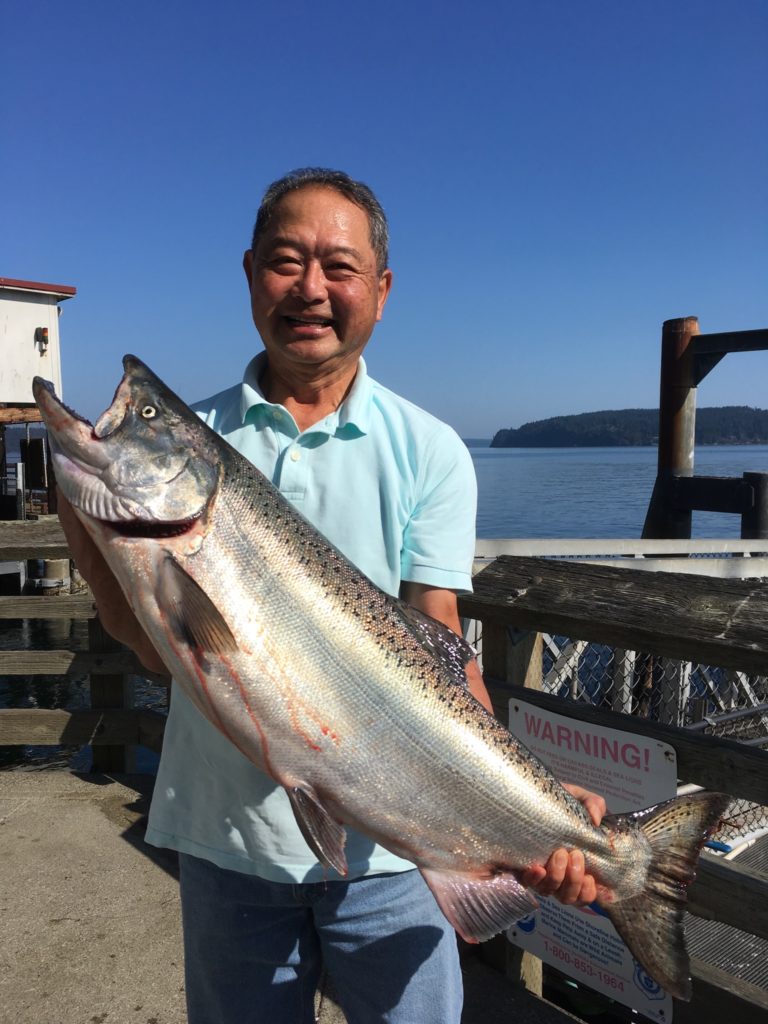
The number of saltwater salmon fishing opportunities continues to ramp up heading into July, and, hopefully, the decent catches seen in open areas last month are a signal of what lies ahead for the remainder of summer:
South-Central Puget Sound (Marine Area 11): Case in point: The hatchery-marked Chinook caught when south-central Puget Sound was open June 1-3 were some of the best seen in a long time, and so good that the first half of the Chinook quota was achieved in a matter of a few days. Area 11 reopens daily from July 1-September 30 with an allowable catch quota of 2,816 and a total sublegal encounter limit of 3,373 (Chinook under the 22-inch minimum size limit). The length of the summer Chinook fishery is dictated by the catch quota, so going sooner rather than later should guarantee you time on the water.
San Juan Islands (Marine Area 7): There is also a small window of opportunity for summer hatchery-marked Chinook in the San Juan Islands, which is open July 14-16 only and additional days may be added based on in-season updates. The Islands’ Chinook quota is 1,800 (up from 1,382 in 2021 and 1,562 in 2020). Fishing is also planned to reopen August 16-September 30 for hatchery coho only.
Northern Puget Sound (Marine Area 9): This fishery opens for hatchery-marked Chinook on July 14-16 and July 21-23 and then will be open daily from July 28-August 15 if enough of the 4,700-Chinook quota (4,700 in 2021 and 5,600 in 2020) is still available after the initial first two openers. It then reopens daily from August 16-September 25 for hatchery-marked coho only.
Central Puget Sound (Marine Area 10): This resident coho only fishery remains open daily through July 13 with most fish averaging 2 to 4 pounds. It then shifts into a hatchery-marked Chinook and coho fishery from July 14-August 31. Chinook retention could close sooner if the 3,966 quota is achieved (3,718 in 2021 and 4,100 in 2020).
Strait of Juan de Fuca at Sekiu (Marine Area 5): This much-beloved region opens July 1-August 15 for hatchery-marked Chinook and coho, and the small town nestled on Clallam Bay is known to produce some dandy kings—10 to 15 pounds with some exceeding 35 pounds. The Chinook retention fishery at Sekiu could close sooner if the 3,890-catch quota is achieved.
Eastern Strait at Port Angeles (Marine Area 6): Located west of a true north-south line through the No. 2 Buoy immediately east of Ediz Hook, this fishery opens July 1-August 15 for hatchery-marked Chinook and coho. The Chinook retention fishery could close sooner if the 6,050 quota (4,769 in 2021) is achieved. The area east of that north-south line is open July 1-Aug. 15 for hatchery-marked coho only.
Hood Canal south of Ayock Point (Marine Area 12): This is another area that doesn’t get much attention, but has been rather productive in early July for hatchery Chinook. This stretch of Hood Canal is open July 1-September 30 for coho and hatchery-marked Chinook with a liberal daily limit of four salmon and a minimum size limit of 20 inches.
And Much, Much More: Off the coast, head to La Push (Marine Area 3), Neah Bay (Marine Area 4) and Ilwaco (Marine Area 1), which are open daily for salmon retention. Westport (Marine Area 2) is open daily beginning July 2. All areas are scheduled to remain open through September 30 or until quotas are met, with species and size restrictions dependent on the area. Other salmon options in July are the Tulalip Terminal Fishery open Fridays to Mondays only for Chinook; and southern Puget Sound (Marine Area 13) as well as many docks and piers that are open year-round for salmon.
Advice for Anglers: Migrating summer Chinook don’t tend to stick around in one spot for very long as they head to natal spawning grounds. The best action tends to occur during early mornings when they’re suspended in the upper and middle water column. As the sun rises, the king head to deeper waters and can be usually found near the bottom. Other important keys to success are locating baitfish schools at the proper depth and getting your presentation into the mix and looking at a tide chart to determine if you’ll have any luck at catching a fish.
You can find a detailed list of statewide marine and freshwater salmon fisheries on the WDFW website at wdfw.wa.gov/fishing/management/north-falcon/summaries. In the next issue of the magazine, I’ll dive even further into August salmon fishing options as the list of opportunities grows even larger. I’ll see you on the water very soon!


